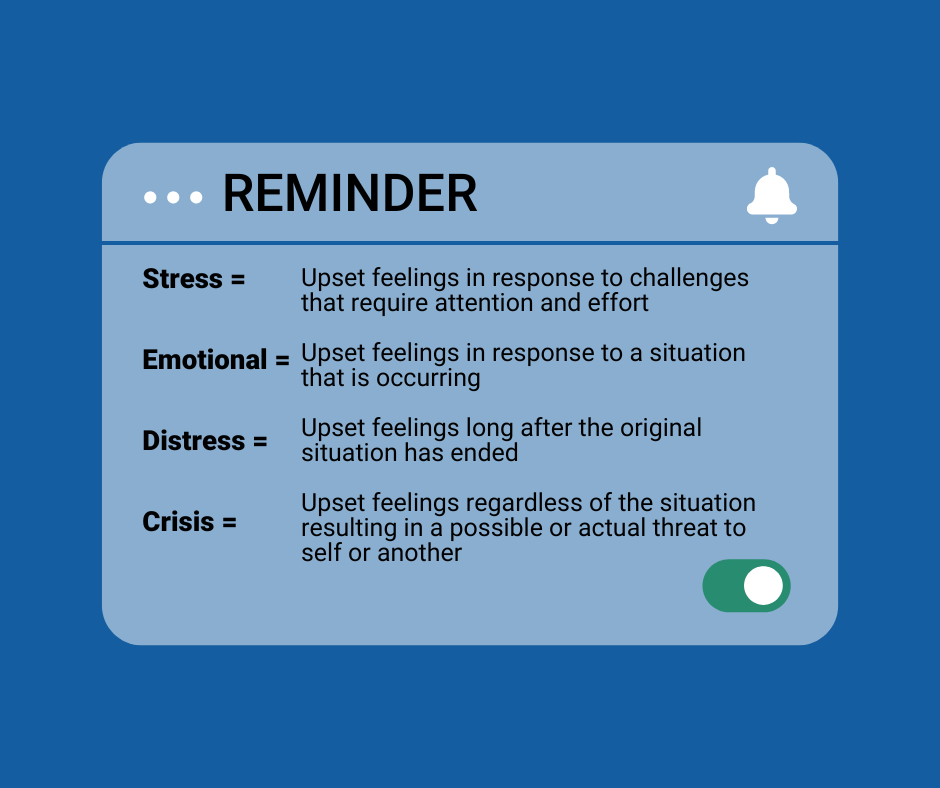We go into another school year, this time hoping there is more usualness than in the last two years. Even with that, there remain concerns about students and their mental health and well-being.
Common concerns we hear include:
- I am worried about the mental health and well-being of my students and feel under-equipped and less confident to know what to do to be helpful.
- I am having to manage not only the mental health and well-being of my students and my colleagues but also my own and those at home. How do I manage it all?
Here are 5 tips to assist you while working and living in our current world.
Tip #1 – Stress & Emotionality Do Not Equal Distress & Crisis
Most of our students are not in crisis when they are upset. We spend too much time reinforcing how “depressed” and “anxious” students are, when most (though not all), are feeling upset about something happening to them that is frankly. . . .well. . .upsetting.
When I am upset about something, I do not want others immediately suggesting I talk to a counselor or that I am in crisis. That would leave me feeling that things may be worse than they are. The same is true for our students. When a student is upset, remember this scale:

The Stress to Crisis continuum
We often react to student stress and emotionality like it is distress and crisis. When students are stressed or emotional, they often just need to talk to someone they know, like you.
Not every upset student is in distress or crisis. It is hard enough to be upset. Becoming upset about being upset makes it worse. Help your students keep perspective. Helps them and helps you, too!
Tip #2 – You Must Be At Least This Tall to Ride This Ride
Everyone has ups and downs, involved times and lonely times, and successes and mistakes. Though we know these fluctuations are part of every picture, we can lean too readily into mistakes and down periods seeming more like personal failures.
You can normalize the ups and downs for your students as “just the rollercoaster that life is.” Do this by sharing your own peaks and valleys, personal stories of when things are not or did not go well for you in your work, school, or life. Normalizing life’s ups and downs better encourages students to stay connected to the work they do with you.
You can also remind them to simply “hang in there,” as you sometimes do yourself, so they can worry less about disappointing themselves and you when things do not always go as hoped.
Tip #3 – Best Check Your Norms, Before You Wreck Your Norms
Navigating life these days is harder than it has been. Despite this, students tell us over and over that some teachers have done a good job making small expectation adjustments to accommodate larger world challenges, and others have not done anything at all.
Norms work best when they can flex to fit changing contexts. For a class I teach, I generally assign a presentation, a test, and a paper. In 2020, I deleted the paper while also increasing expectations for the presentation and test.
Students are appreciative of the adjustment to these expectations. The class is not overall less work, but removing one element from long-standing class norms allows other class expectations to feel more manageable, without compromising overall class expectations.
Look at your own normative expectations to see where you can adjust. Having expectations of your students is important, just check your norms to make sure they fit the current context. They will thank you and . . .you will thank you!
Tip #4 – It’s Integration, Not Balance
How much do we accept the concept of “work-life balance?” Balance sets us up for feeling fraud and failure. Who can keep balance all the time? We fare better when we consider integration, where sometimes we work more than we play and other times we play more than we work.
It is integration of these two, not always keeping them in balance. Otherwise, we always feel out of balance as semesters move and change. Remind your students (and yourself), that the natural ebb and flow of working and playing are both positive for us. Without this integration, burnout lurks around the corner as does the feeling of “not doing enough,” “not doing as well as the next person,” and “not measuring up.” Work-life integration gives us time for work over play and play over work.
Tip #5 – Resources, Resources, Resources!
Schools, AEAs, and our Center have resources for support, guidance, and assistance. A common mistake is not reaching out. When in doubt, remind your students to contact support services and remind yourself to do the same when you need support and consultation, too!
The return to school continues to be challenging. With some ideas of how to manage the challenge for both your students and yourself, this school year can be a wonderful time to continue to grow as individuals and in relationships with each other.
President Harry Truman gave the best guidance when he stated: “I have found the best way to give advice is to find out what someone wants and advise them to do it.”
Best wishes for the new school year!
